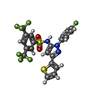[English] 日本語
 Yorodumi
Yorodumi- PDB-2g0h: Structure-based drug design of a novel family of PPAR partial ago... -
+ Open data
Open data
- Basic information
Basic information
| Entry | Database: PDB / ID: 2g0h | ||||||
|---|---|---|---|---|---|---|---|
| Title | Structure-based drug design of a novel family of PPAR partial agonists: virtual screening, x-ray crystallography and in vitro/in vivo biological activities | ||||||
 Components Components | Peroxisome proliferator-activated receptor gamma | ||||||
 Keywords Keywords | TRANSCRIPTION ACTIVATOR / PPAR | ||||||
| Function / homology |  Function and homology information Function and homology informationprostaglandin receptor activity / : / negative regulation of receptor signaling pathway via STAT / MECP2 regulates transcription factors / negative regulation of vascular endothelial cell proliferation / negative regulation of extracellular matrix assembly / negative regulation of connective tissue replacement involved in inflammatory response wound healing / positive regulation of cholesterol transport / negative regulation of cellular response to transforming growth factor beta stimulus / arachidonate binding ...prostaglandin receptor activity / : / negative regulation of receptor signaling pathway via STAT / MECP2 regulates transcription factors / negative regulation of vascular endothelial cell proliferation / negative regulation of extracellular matrix assembly / negative regulation of connective tissue replacement involved in inflammatory response wound healing / positive regulation of cholesterol transport / negative regulation of cellular response to transforming growth factor beta stimulus / arachidonate binding / positive regulation of adiponectin secretion / negative regulation of cardiac muscle hypertrophy in response to stress / DNA binding domain binding / lipoprotein transport / positive regulation of vascular associated smooth muscle cell apoptotic process / WW domain binding / positive regulation of fatty acid metabolic process / STAT family protein binding / response to lipid / negative regulation of type II interferon-mediated signaling pathway / LBD domain binding / negative regulation of cholesterol storage / negative regulation of SMAD protein signal transduction / lipid homeostasis / E-box binding / alpha-actinin binding / R-SMAD binding / negative regulation of vascular associated smooth muscle cell proliferation / negative regulation of blood vessel endothelial cell migration / monocyte differentiation / white fat cell differentiation / cellular response to low-density lipoprotein particle stimulus / negative regulation of macrophage derived foam cell differentiation / negative regulation of lipid storage / positive regulation of cholesterol efflux / negative regulation of BMP signaling pathway / cell fate commitment / negative regulation of osteoblast differentiation / negative regulation of mitochondrial fission / positive regulation of fat cell differentiation / BMP signaling pathway / long-chain fatty acid transport / nuclear retinoid X receptor binding / Transcriptional regulation of brown and beige adipocyte differentiation by EBF2 / retinoic acid receptor signaling pathway / cell maturation / negative regulation of MAPK cascade / intracellular receptor signaling pathway / hormone-mediated signaling pathway / positive regulation of adipose tissue development / peroxisome proliferator activated receptor signaling pathway / epithelial cell differentiation / response to nutrient / regulation of cellular response to insulin stimulus / peptide binding / negative regulation of miRNA transcription / negative regulation of angiogenesis / placenta development / Regulation of PTEN gene transcription / transcription coregulator binding / positive regulation of apoptotic signaling pathway / SUMOylation of intracellular receptors / negative regulation of smooth muscle cell proliferation / negative regulation of transforming growth factor beta receptor signaling pathway / mRNA transcription by RNA polymerase II / PPARA activates gene expression / fatty acid metabolic process / regulation of circadian rhythm / Nuclear Receptor transcription pathway / Transcriptional regulation of white adipocyte differentiation / positive regulation of miRNA transcription / lipid metabolic process / negative regulation of inflammatory response / DNA-binding transcription repressor activity, RNA polymerase II-specific / regulation of blood pressure / RNA polymerase II transcription regulator complex / nuclear receptor activity / cellular response to insulin stimulus / rhythmic process / glucose homeostasis / MLL4 and MLL3 complexes regulate expression of PPARG target genes in adipogenesis and hepatic steatosis / DNA-binding transcription activator activity, RNA polymerase II-specific / double-stranded DNA binding / cellular response to hypoxia / sequence-specific DNA binding / DNA-binding transcription factor binding / nucleic acid binding / DNA-binding transcription factor activity, RNA polymerase II-specific / cell differentiation / receptor complex / transcription cis-regulatory region binding / RNA polymerase II cis-regulatory region sequence-specific DNA binding / DNA-binding transcription factor activity / negative regulation of gene expression / innate immune response / negative regulation of DNA-templated transcription / intracellular membrane-bounded organelle / chromatin binding / positive regulation of gene expression / regulation of transcription by RNA polymerase II Similarity search - Function | ||||||
| Biological species |  Homo sapiens (human) Homo sapiens (human) | ||||||
| Method |  X-RAY DIFFRACTION / X-RAY DIFFRACTION /  SYNCHROTRON / SYNCHROTRON /  MOLECULAR REPLACEMENT / Resolution: 2.3 Å MOLECULAR REPLACEMENT / Resolution: 2.3 Å | ||||||
 Authors Authors | Lu, I.L. / Peng, Y.H. / Huang, C.F. / Lin, Y.T. / Hsu, J.T.A. / Wu, S.Y. | ||||||
 Citation Citation |  Journal: J.Med.Chem. / Year: 2006 Journal: J.Med.Chem. / Year: 2006Title: Structure-Based Drug Design of a Novel Family of PPARgamma Partial Agonists: Virtual Screening, X-ray Crystallography, and in Vitro/in Vivo Biological Activities Authors: Lu, I.L. / Huang, C.F. / Peng, Y.H. / Lin, Y.T. / Hsieh, H.P. / Chen, C.T. / Lien, T.W. / Lee, H.J. / Mahindroo, N. / Prakash, E. / Yueh, A. / Chen, H.Y. / Goparaju, C.M. / Chen, X. / Liao, ...Authors: Lu, I.L. / Huang, C.F. / Peng, Y.H. / Lin, Y.T. / Hsieh, H.P. / Chen, C.T. / Lien, T.W. / Lee, H.J. / Mahindroo, N. / Prakash, E. / Yueh, A. / Chen, H.Y. / Goparaju, C.M. / Chen, X. / Liao, C.C. / Chao, Y.S. / Hsu, J.T. / Wu, S.Y. | ||||||
| History |
|
- Structure visualization
Structure visualization
| Structure viewer | Molecule:  Molmil Molmil Jmol/JSmol Jmol/JSmol |
|---|
- Downloads & links
Downloads & links
- Download
Download
| PDBx/mmCIF format |  2g0h.cif.gz 2g0h.cif.gz | 120.9 KB | Display |  PDBx/mmCIF format PDBx/mmCIF format |
|---|---|---|---|---|
| PDB format |  pdb2g0h.ent.gz pdb2g0h.ent.gz | 95.1 KB | Display |  PDB format PDB format |
| PDBx/mmJSON format |  2g0h.json.gz 2g0h.json.gz | Tree view |  PDBx/mmJSON format PDBx/mmJSON format | |
| Others |  Other downloads Other downloads |
-Validation report
| Summary document |  2g0h_validation.pdf.gz 2g0h_validation.pdf.gz | 1.1 MB | Display |  wwPDB validaton report wwPDB validaton report |
|---|---|---|---|---|
| Full document |  2g0h_full_validation.pdf.gz 2g0h_full_validation.pdf.gz | 1.1 MB | Display | |
| Data in XML |  2g0h_validation.xml.gz 2g0h_validation.xml.gz | 24.1 KB | Display | |
| Data in CIF |  2g0h_validation.cif.gz 2g0h_validation.cif.gz | 32.2 KB | Display | |
| Arichive directory |  https://data.pdbj.org/pub/pdb/validation_reports/g0/2g0h https://data.pdbj.org/pub/pdb/validation_reports/g0/2g0h ftp://data.pdbj.org/pub/pdb/validation_reports/g0/2g0h ftp://data.pdbj.org/pub/pdb/validation_reports/g0/2g0h | HTTPS FTP |
-Related structure data
| Related structure data |  2g0gC 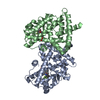 2athS C: citing same article ( S: Starting model for refinement |
|---|---|
| Similar structure data |
- Links
Links
- Assembly
Assembly
| Deposited unit | 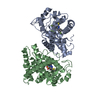
| ||||||||
|---|---|---|---|---|---|---|---|---|---|
| 1 |
| ||||||||
| Unit cell |
| ||||||||
| Details | The second part of the biological assembly is generated by the two fold axis: -x, y+1/2, -z; |
- Components
Components
| #1: Protein | Mass: 30997.021 Da / Num. of mol.: 2 / Fragment: Ligand binding domain(residues 207-477) Source method: isolated from a genetically manipulated source Source: (gene. exp.)  Homo sapiens (human) / Gene: PPARG, NR1C3 / Plasmid: pGEX6P-1 / Species (production host): Escherichia coli / Production host: Homo sapiens (human) / Gene: PPARG, NR1C3 / Plasmid: pGEX6P-1 / Species (production host): Escherichia coli / Production host:  #2: Chemical | #3: Water | ChemComp-HOH / | |
|---|
-Experimental details
-Experiment
| Experiment | Method:  X-RAY DIFFRACTION / Number of used crystals: 1 X-RAY DIFFRACTION / Number of used crystals: 1 |
|---|
- Sample preparation
Sample preparation
| Crystal | Density Matthews: 2.36 Å3/Da / Density % sol: 47.85 % |
|---|---|
| Crystal grow | Temperature: 291 K / Method: vapor diffusion, hanging drop / pH: 8 Details: 20% PEG3350, pH 8.0, VAPOR DIFFUSION, HANGING DROP, temperature 291K |
-Data collection
| Diffraction | Mean temperature: 100 K |
|---|---|
| Diffraction source | Source:  SYNCHROTRON / Site: SYNCHROTRON / Site:  SPring-8 SPring-8  / Beamline: BL12B2 / Wavelength: 1 Å / Beamline: BL12B2 / Wavelength: 1 Å |
| Detector | Type: ADSC QUANTUM 4 / Detector: CCD / Date: May 26, 2005 |
| Radiation | Monochromator: Monochromator / Protocol: SINGLE WAVELENGTH / Monochromatic (M) / Laue (L): M / Scattering type: x-ray |
| Radiation wavelength | Wavelength: 1 Å / Relative weight: 1 |
| Reflection | Resolution: 2.3→20 Å / Num. obs: 24250 / % possible obs: 99.8 % / Observed criterion σ(F): 0 / Observed criterion σ(I): 0 |
| Reflection shell | Resolution: 2.3→2.359 Å / % possible all: 100 |
- Processing
Processing
| Software |
| ||||||||||||||||||||
|---|---|---|---|---|---|---|---|---|---|---|---|---|---|---|---|---|---|---|---|---|---|
| Refinement | Method to determine structure:  MOLECULAR REPLACEMENT MOLECULAR REPLACEMENTStarting model: 2ATH Resolution: 2.3→20 Å / σ(F): 3.78 / Stereochemistry target values: Engh & Huber
| ||||||||||||||||||||
| Refinement step | Cycle: LAST / Resolution: 2.3→20 Å
| ||||||||||||||||||||
| Refine LS restraints |
|
 Movie
Movie Controller
Controller




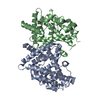

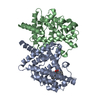


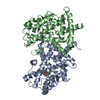

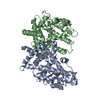
 PDBj
PDBj